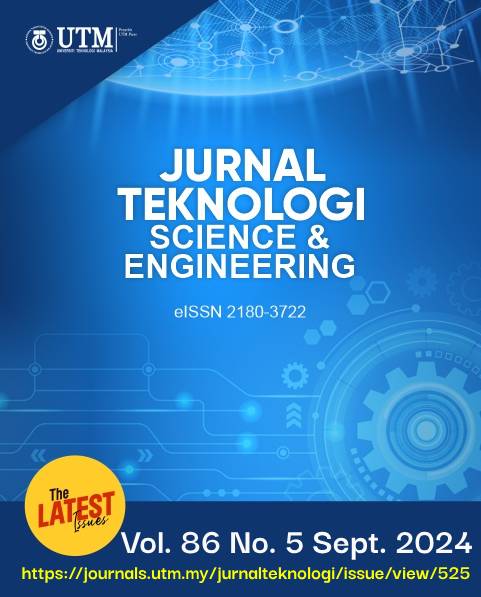DISASTER MITIGATION FOR PEOPLE WITH CEREBRAL PALSY BASED ON BEHAVIORAL ARCHITECTURE IN RESIDENTIAL USING WIRELESS SENSOR NETWORK
DOI:
https://doi.org/10.11113/jurnalteknologi.v86.21106Keywords:
Wireless sensor network, cerebral palsy, behavioral architecture, disaster mitigation, sensorsAbstract
At this time, most houses for persons with disabilities are not yet equipped with a disaster mitigation system. It may be difficult for persons with disabilities to be able to save themselves when a disaster occurs. Therefore, in this study, a system for disaster mitigation, especially fires in the residence of a child with cerebral palsy, has been successfully designed. The optimal placement of the wireless sensor network is decided based on a behavioral architectural analysis using the DepthMapX-0.7.0 software. Behavioral architecture assessment begins by observing patterns of daily activities and a simulation of human movement in the house to find out the most frequent activity places used by children with cerebral palsy. Based on the test results with DepthMapX-0.7.0, it can be concluded that the optimal location of the sensor node points is in the child's bedroom, kitchen, and TV room. The designed wireless sensor network consists of three sensor nodes and a gateway node. Data sampling is performed every 15 seconds. If a fire is identified, the buzzer will emit a warning signal. In addition, the child's family can monitor home conditions from the ThingSpeak.com website and Telegram.
References
Republika. 2022. Kebakaran DKI Mayoritas di Jakarta Selatan. Accessed Aug. 25, 2022.
G. Kbar, A. Al-Daraiseh, S. H. Mian, and M. H. Abidi. 2016. Utilizing Sensors Networks to Develop a Smart and Context-aware Solution for People with Disabilities at the Workplace (Design and Implementation). Int. J. Distrib. Sens. Networks. 12(9). Doi: 10.1177/1550147716658606.
D. R. Patel, M. Neelakantan, K. Pandher, and J. Merrick. 2020. Cerebral Palsy in Children: A Clinical Overview. Transl. Pediatr. 1: S125-S135. Doi: 10.21037/tp.2020.01.01.
A. Adeel et al. 2019. A Survey on the Role of Wireless Sensor Networks and IoT in Disaster Management. Springer Singapore.
S. Srivastava, M. Singh, and S. Gupta. 2019. Wireless Sensor Network: A Survey. 2018 Int. Conf. Autom. Comput. Eng. ICACE 2018. November 2018: 159-163. Doi: 10.1109/ICACE.2018.8687059.
D. Kandris, C. Nakas, D. Vomvas, and G. Koulouras. 2020. Applications of Wireless Sensor Networks: An Up-to-date Survey. Appl. Syst. Innov. 3(1): 1-24. Doi: 10.3390/asi3010014.
J. Al Qundus, K. Dabbour, S. Gupta, R. Meissonier, and A. Paschke. 2022. Wireless Sensor Network for AI-based Flood Disaster Detection. Ann. Oper. Res. 319(1): 697-719. Doi: 10.1007/s10479-020-03754-x.
A. J. Wilson and A. S. Radhamani. 2022. Real Time Flood Disaster Monitoring based on Energy Efficient Ensemble Clustering Mechanism in Wireless Sensor Network. Softw. - Pract. Exp. 52(1): 254-276. Doi: 10.1002/spe.3019.
E. A. Kadir, H. Irie, and S. L. Rosa. 2019. Modeling of Wireless Sensor Networks for Detection Land and Forest Fire Hotspot. 2019 International Conference on Electronics, Information, and Communication (ICEIC). 1-5.
I. Kebahagiaan, S. Utara, T. Sebesar, and P. Skala. 2015. Indeks Kebahagiaan Sulawesi Utara Tahun 2014. 13: 1-5.
S. M. Zakaria Al-Hady, M. R. Islam, and M. M. Rashid. 2023. Development of IoT-based Automated Dynamic Emergency Response System against Fire Incidents in Academic Building. Int. J. Eng. Mater. Manuf. 8(3): 75-87. Doi: 10.26776/ijemm.08.03.2023.03.
R. U. Islam. 2017. Wireless Sensor Network Based Flood Prediction Using Belief Rule Based Expert System. Thesis. Lulea University of Technology Skelleftea, Sweden.
D. Chen, Z. Liu, L. Wang, M. Dou, J. Chen, and H. Li. 2013. Natural Disaster Monitoring with Wireless Sensor Networks: A Case Study of Data-intensive Applications upon Low-Cost Scalable Systems. Mob. Networks Appl. 18(5): 651-663. Doi: 10.1007/s11036-013-0456-9.
A. Afghantoloee and M. A. Mostafavi. 2018. Towards Optimal Deployment of a Sensor Network in a 3D Indoor Environment for the Mobility of People with Disabilities. Leibniz Int. Proc. Informatics, LIPIcs. 114(19): 1-6. Doi: 10.4230/LIPIcs.GIScience.2018.19.
D. Pant, S. Bhattarai, and S. Poudel. 2021. Smart Care: Body Area Sensor Network Conceptual Architecture For Elderly And Non-Critical Patient Care. Int. J. Adv. Netw. Appl. 12(05): 4706-4713. Doi: 10.35444/ijana.2021.12506.
Y. J. Chang and T. Y. Wang. 2010. Indoor Wayfinding based on Wireless Sensor Networks for Individuals with Multiple Special Needs. Cybern. Syst. 41(4): 317-333. Doi: 10.1080/01969721003778584.
N. Parihar. 2019. A Review Paper on Healthcare and Hospital Monitoring System Using Wireless Sensor Network. 8(1): 62-68,
A. Hadjidj, M. Souil, A. Bouabdallah, Y. Challal, and H. Owen. 2013. Wireless Sensor Networks for Rehabilitation Applications: Challenges and Opportunities. J. Netw. Comput. Appl. 36(1): 1-15. Doi: 10.1016/j.jnca.2012.10.002.
I. M. Khan, N. Jabeur, M. Z. Khan, and H. Mokhtar. 2012. An Overview of the Impact of Wireless Sensor Networks in Medical Health Care. 1st Int. Conf. Comput. Inf. Technol. (ICCIT’2012), Al-Madinah Al-Munawwarah, Saudi Arab. Doi: 10.13140/2.1.3136.3524.
P. Pandey and R. Litoriya. 2020. Elderly Care through Unusual Behavior Detection: A Disaster Management Approach using IoT and Intelligence. IBM J. Res. Dev. 64(1-2): 1-11. Doi: 10.1147/JRD.2019.2947018.
H. Derya Arslan and H. Ergener. 2023. Comparative Analysis of Shopping Malls with Different Plans by using Space Syntax Method. Ain Shams Eng. J. 14(9): 102063. Doi: 10.1016/j.asej.2022.102063.
Rudolf Sitorus and Sania Ariany Siregar. 2021. Creativity Center for Child-Friendly Settlements in Kampung Hamdan-Sukaraja with Behavioral Architecture Approach. Int. J. Archit. Urban. 5(1): 37-48. Doi: 10.32734/ijau.v5i1.6030.
Z. I. Khairuni and K. Jeumpa. 2021. Behavioral Architecture Approach to Concept of Housing for the Face of Pandemic. Int. J. Archit. Urban. 5(2): 134-147. Doi: 10.32734/ijau.v5i2.6378.
A. Ibrahim. 2016. Architectural Design Process based on Spatial Human Behavior Parameters through Computational Methodology Soft Adaptive Skins for Energy Efficient Architecture View project Architectural Form Finding Strategies View project. October: 0-15. https://www.researchgate.net/publication/318114479.
J. Matejcek and O. Pribyl. 2020. Space Syntax: A Multi-disciplinary Tool to Understand City Dynamics. 2020 Smart Cities Symp. Prague, SCSP 2020. Doi: 10.1109/SCSP49987.2020.9133884.
C. 101. 2024. Components 101. https://components101.com/ (accessed Feb. 13, 2024).
S. Pasha. 2016. Thingspeak based Sensing and Monitoring Systemfor IoT with Matlab Analysis. Int. J. New Technol. Res. 2(6): 19-23. www.ijntr.org.
Downloads
Published
Issue
Section
License
Copyright of articles that appear in Jurnal Teknologi belongs exclusively to Penerbit Universiti Teknologi Malaysia (Penerbit UTM Press). This copyright covers the rights to reproduce the article, including reprints, electronic reproductions, or any other reproductions of similar nature.
















